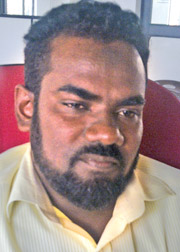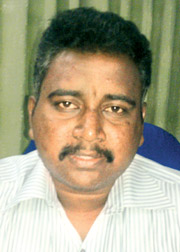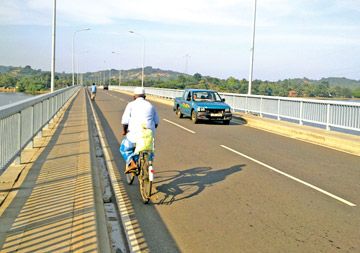Kinniya Bridge - harbinger of prosperity to East
Mohammed NAALIR reporting from Trincomalee
The Kinniya Divisional Secretariat division in the Trincomalee
District located along the Eastern coastal belt has a cause for
celebration - Sri Lanka's longest bridge constructed across the Kinniya
bay connecting Wellaimanal and Kinniya is the Kinniya bridge. In
operation for over one year, the bridge has proved to be a lifeline for
the people in the East.
 |
 |
Kinniya Divisional
Secretary
M. Mubarak |
Kinniya Assistant
Divisional Secretary C. Krishnnendran |
Sri Lanka's longest bridge constructed in fulfilment of the concept
of the "Mahinda Chinthanaya" with financial assistance provided by the
Kingdom of Saudi Arabia when Senior Presidential Advisor and Present
Economic Development Minister Basil Rajapaksa, was a parliamentarian was
opened by President Mahinda Rajapaksa on October 20, 2009 on an
invitation extended by Highways Minister T.B. Ekanayake.
As the transport issue of this area was solved domestic industries in
the area have been revived. It has also become a boon to the tourism
sector, both domestic and foreign. According to rough estimates of the
Kinniya Divisional Secretariat, nearly 50,000 domestic tourists have
visited the bridge last year.
The people are engaged in handicraft industry with the arrival of
tourists. According to the sources of Kinniya Divisional Secretariat
certain houses have been converted into guest houses to provide
accommodation to tourists.
Even-though the bridge is a gateway for economic prosperity of the
area, it has caused concern in certain other ways, said M.M. Baseer,
Secretary, Kinniya Urban Council.
He further said that certain areas that reman in darkness are misused
by lovers during the night. "Certain children's parks have also become
the asylum of lovers during night. The bridge has contributed to the
economy of the area on a huge scale. These activities were not seen
before the opening of the bridge.
The police have brought this to the notice of the authorities.
The Kinniya Urban Council also decided to install lighting in these
areas. Before the bridge was built, construction activities in this area
took place amidst immense difficulties. There was little access for
heavy vehicles.
Alternative routes
It took a long time to come through alternative routes. The
Thambalagamuwa main road was in a dilapidated condition. Kinniya was
virtually separated from other parts of the District. Due to the
unavailability of resources and poor communication with other areas the
economy of this area was crippled.
The Kinniya Divisional Secretary M.M. Mubarak said that economically
a huge change had taken place in the area. Raw materials are brought on
time and the harvest reaches the market without perishing. Government
servants who are employed in Trincomalee city benefit immensely.
Government servants earlier spent a long time waiting for ferry boats.
Now they could cut down on additional expenditure after the opening of
the bridge.
Those wishing to cross the lagoon had to wait for more than one and a
half hours at the jetty waiting for the ferry boat.
 |
|
The Kinniya bridge
Pix: Mohammed Naalir |
Now people are able to cross the Kinniya bay via the new bridge in
minutes. Prior to the erection of the bridge it took nearly three hours
to get to Trincomalee.
According to the Assistant Divisional Secretary C. Krishnendran,
people in Kinniya experienced untold hardships due to the old ferry boat
service. There were a lot of deficiencies in the service. There were
only two ferry boats but sometimes only one was in operation. This was
the only transport mode for nearly 80,000 people in the Kinniya area.
The small ferries could accommodate only a few passengers. The journey
on a ferry was a journey between life and death. When vehicles were
transported several vehicles had fallen into the lagoon from the
ferries. Only 60 to 70 persons can be accommodated on board the ferry.
This number decreases when vehicles are accommodated on board. Then
only 20 to 30 foot passengers can be accommodated on board.
Price of fuel
As the price of fuel and spare parts went up, the Road Development
Authority restricted the number of ferry journeys per day. With the
opening of the bridge the expenditure of the RDA has reduced.
A large number of vehicles loaded with vegetables and other produce
ply via the Kinniya bridge to Trincomalee and other parts of the
District.
As Kinniya is located close to the lagoon there are abundant aquatic
resources. On the other hand as Kinniya is located close to Mahaweli
river there are enough facilities to uplift agricultural activities in
this area.
The construction of the bridge can be considered as the gateway for
the advancement of agriculture in this area.
According to Mubarak there are enough aquatic resources even for
export. A large number of Kinniya residents are engaged in mining sea
shells.
A person earns more than Rs. 2000 daily through selling sea shells to
dealers.
A large number of businessmen are engaged in transporting sea shells
to other parts of the country from Kinniya. The fish caught in the
Kinniya sea area is being transported to Colombo and other parts of the
country daily via the Kinniya bridge.
Opportunities have arisen for entrepreneurs from grassroots level to
top level to strengthen their businesses. Nearly 200 vegetable sellers
use the bridge daily to take their produce to Trincomalee and other
parts of the country.
The handicraft industry has also received a boost in this area.
People who travel to Seruwila and Muttur now use the Kinniya route.
Prior to the floods, people used this route to go to Batticaloa and
Ampara. Through the journey via Kinniya passengers can save more than
three hours of their entire travel time.
|

